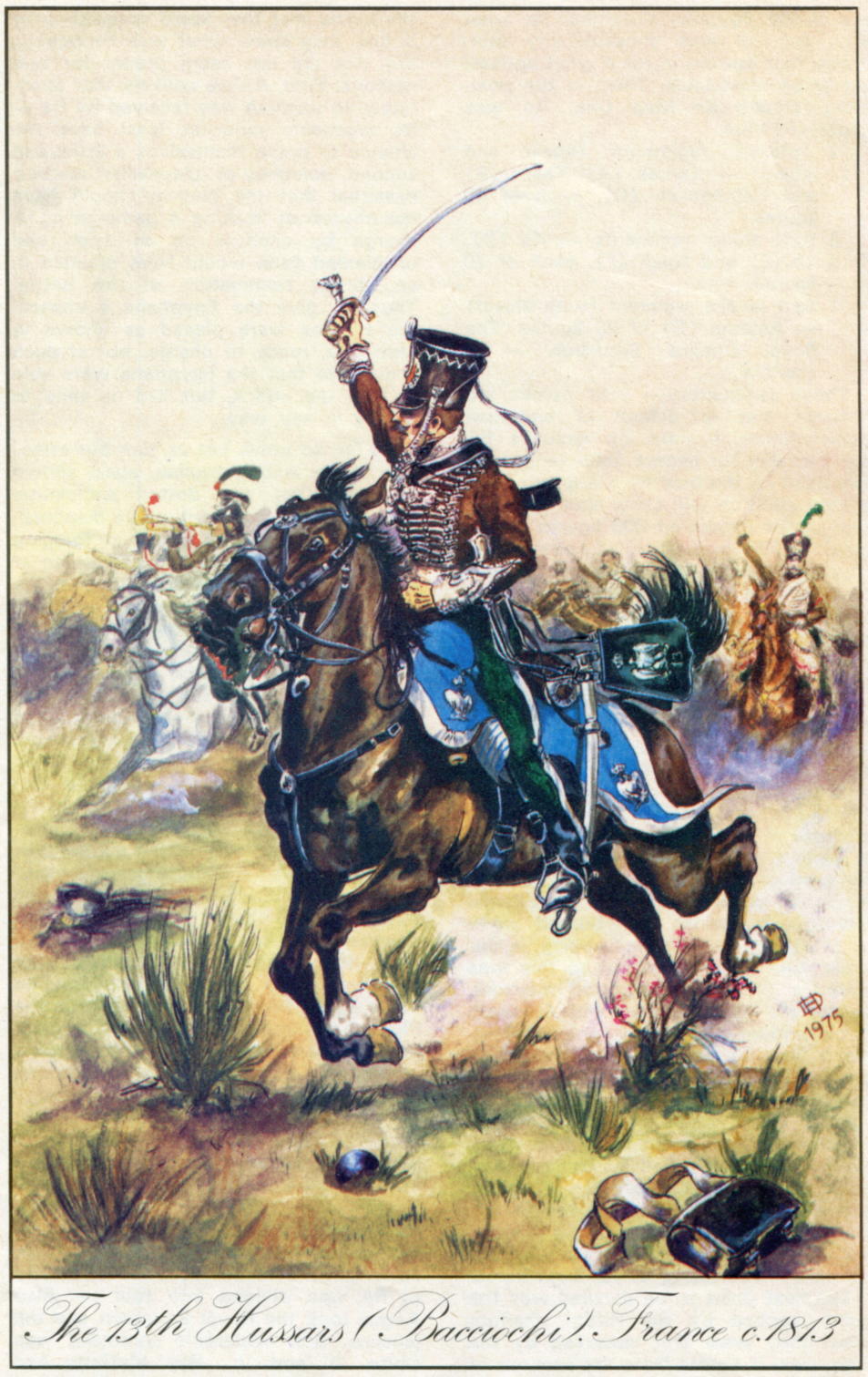Amazon Prime Student 6-month Trial

Try Amazon Fresh
UNIFORM OF THE MONTH
Military Modelling, November 1975
13th Hussars (Bacciochi).
France c.1813
A new series - No. 1 by D. H. Hagger

THE 13th Hussars (Bacciochi) was one of the short-lived units raised towards the end of the Napoleonic era, when the Emperor's star was already on the wane.
There were in fact two regiments of French hussars numbered 13, the other being the 13th Hussars (Jerome Napoleon) which will be the subject of a future article.
The 13th (Bacciochi) was created by an Imperial decree of the 28th January, 1813, and the organisation of the new unit was entrusted by Napoleon to his sister, Elisa Bacciochi, Grand Duchess of Tuscany, which explains the name of Bacciochi in the regiment's title.
The first two squadrons were organised at Rome on the 5th March under the direction of General Miollis with men provided from the Department of Rome and elsewhere.
The staff, 3rd and 4th squadrons were formed on the 18th February with men from Tuscany.
The war squadrons joined the Grand Army in Germany towards June of 1813 in time to take part in the Battle of Leipzig under their colonel, Bureaux De. Pusy.
The regiment was practically annihilated and the remnants incorporated into the infantry.
Part of the regiment had, however, remained in Italy.
This was the 9th Company which formed the depot at Pisa.
On the 4th December, 1813, an Imperial decree created a 10th Company with conscripts from France and together these two companies were formed into a 5th Squadron of 275 sabres which took part in operations against the English who were attempting to land on the coast of Viareggio.
However this activity was short-lived because a further decree of the 13th December, 1813 pronounced the dissolution of the regiment and its remaining elements were incorporated into the 14th Hussars at Turin.
According to the decree of organisation, the 13th Hussars were to have adopted the uniform of the 8th of the arm but owing to an error by a clerk at the Ministry of War in transmitting the orders the 13th in fact received the uniform of the 2nd Hussars.
The various squadrons thus wore the familiar chestnut brown and sky-blue of the uniform of the Chamborant Hussars save only that the collar of the dolman was brown instead of sky-blue.
Some doubt exists as to the head-dress of the 13th upon its formation.
That for the elite company was a busby (possibly later exchanged for the 1812 pattern of grenadier shako), but for the line companies a red shako was prescribed; whether this was bell-shaped or cylindrical is in question.
Certainly other regiments at this date, the 8th and 9th Hussars for example, wore a red cylindrical shako and there seems no reason to suppose that the 13th did not follow this fashion.
Leinhart and Humbert, however, show the cylindrical shako for this regiment as black.
The sabretache seems to have been of the pattern prescribed under the Bardin regulations of 1812 and is shown in the illustration.
Some sources show a variation in the uniform of the 13th insofar as the sky-blue portions of the uniform, i.e. breeches, cuffs, valise etc., are replaced by dark green.
This may have been due to a shortage of sky-blue cloth, bearing in mind that the clothing manufacturers of the Empire were in some little difficulty to provide the prescribed colours at this time, or possibly by the fact that the Bardin regulations seem to have come down rather heavily in favour of this shade.
Our illustration depicts an officer of the regiment in campaign dress towards the end of 1813 and is based upon a drawing by Benigni in the Bucquoy card series 113.
He wears the green overalls prescribed under the Bardin regulations.
It should be noted that although the fur of his pelisse is white, that of the other ranks was black.
Source: p. 666, Military Modelling, November 1975.
Other 19th Century Illustrations of Costume & Soldiers



